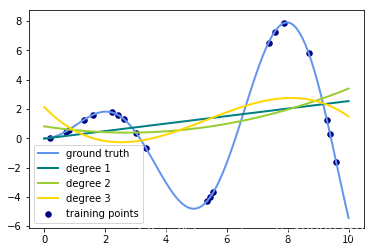(转)Polynomial interpolation 多项式插值
This example demonstrates how to approximate a function with a polynomial of degree n_degree by using ridge regression. Concretely, from n_samples 1d points, it suffices to build the Vandermonde matrix, which is n_samples x n_degree+1 and has the following form:
这个例子演示了如何用岭回归去近似一个函数用n_degree级的多项式级数。具体而言,从n_samples 1d个点,这满足去建立一个范德蒙德矩阵,有n_samples行,n_degree+1列。有如下的形式:
[[1,x1,x1∗∗2,x1∗∗3,…],[1,x2,x2∗∗2,x2∗∗3,…],…][[1,x1,x1∗∗2,x1∗∗3,…],[1,x2,x2∗∗2,x2∗∗3,…],…] [[1, x_1, x_1 ** 2, x_1 ** 3, …], \\ [1, x_2, x_2 ** 2, x_2 ** 3, …], …] [[1,x1,x1∗∗2,x1∗∗3,…],[1,x2,x2∗∗2,x2∗∗3,…],…]
Intuitively, this matrix can be interpreted as a matrix of pseudo features (the points raised to some power). The matrix is akin to (but different from) the matrix induced by a polynomial kernel.
直觉上来说,这个矩阵可以被理解为伪特征的矩阵。这些点提升到能量。
这个矩阵类似于(但不同于) 多项式核生成的矩阵。
This example shows that you can do non-linear regression with a linear model, using a pipeline to add non-linear features. Kernel methods extend this idea and can induce very high (even infinite) dimensional feature spaces.
这个例子显示,你可以用线性模型做非线性回归,通过管道来添加非线性特征。核方法扩展了这个想法,可以导出非常高维的(甚至是无限维)的特征空间。
实验过程
- 注意:
- 这里是用高阶多项式来进行岭回归
- 本质上不是我们日常所说的插值,因为插值点其实并不在对应的位置上。
- 这里说的特征,在其实在fit之前只有一个多项式作为了特征。后面说到了这里采用的是岭回归。


# %pylab inline
# 如果是jupyter notebook就把上面一行注释去掉~
import numpy as np
import matplotlib.pyplot as plt
from sklearn.linear_model import Ridge
from sklearn.preprocessing import PolynomialFeatures
from sklearn.pipeline import make_pipeline
def f(x):
""" function to approximate by polynomial interpolation"""
return x * np.sin(x)
# generate points used to plot
x_plot = np.linspace(0, 10, 100)
# 随机获取20个插值点
# generate points and keep a subset of them
x = np.linspace(0, 10, 100) # 生成100个数据
rng = np.random.RandomState(0)
rng.shuffle(x) # 随机打乱这个数据
x = np.sort(x[:20]) # 将前20个数据排序
y = f(x) # 放入f之中,获取散点的值
# create matrix versions of these arrays
X = x[:, np.newaxis] # 将该数据提高一个维度
X_plot = x_plot[:, np.newaxis]
colors = ['teal', 'yellowgreen', 'gold'] # 颜色集合
lw = 2 # 线宽度
# 真实数据所构成的曲线
plt.plot(x_plot, f(x_plot), color='cornflowerblue', linewidth=lw,
label="ground truth")
# 散点图,描出插值点
plt.scatter(x, y, color='navy', s=30, marker='o', label="training points")
for count, degree in enumerate([3, 4, 5]):
# 用degree的多项式特征结合上岭回归放入到管道之中构建模型
model = make_pipeline(PolynomialFeatures(degree), Ridge())
# print(model)
model.fit(X, y) # 训练模型
y_plot = model.predict(X_plot) # 做出预测
# 描绘出插值曲线
plt.plot(x_plot, y_plot, color=colors[count], linewidth=lw,
label="degree %d" % degree)
plt.legend(loc='lower left')
plt.show()将for循环部分改成这样子:
for count, degree in enumerate([3]):
# 用degree的多项式特征结合上岭回归放入到管道之中构建模型
model = make_pipeline(PolynomialFeatures(degree), Ridge())
model.fit(X, y) # 训练模型
y_plot = model.predict(X_plot) # 做出预测
# 描绘出插值曲线
plt.plot(x_plot, y_plot, color=colors[count], linewidth=lw,
label="degree %d-Ridge" % degree)
model = make_pipeline(PolynomialFeatures(degree), LinearRegression())
model.fit(X, y) # 训练模型
y_plot = model.predict(X_plot) # 做出预测
# 描绘出插值曲线
plt.plot(x_plot, y_plot, color=colors[len(colors) - 1 - count], linewidth=lw,
label="degree %d-linear" % degree)输出的图像为:(只需要将数值从3改成其他degree就可以生成其他图片了)



思考
- 观察:会发现岭回归的结果会线性回归的结果稍显波动小些。
- 回答:岭回归多加了一个L2的范数 约束了多项式特征的w的大小。
最新文章
- 阿里云添加路由的Windows批处理文件
- idea 静态资源不能即时更新
- Javascript中的Prototype到底是啥
- Java 反射练习
- Machine Learning Methods: Decision trees and forests
- mysql 批处理文件--- 创建 用户 以及 导入数据
- 转贴: A Simple c# Wrapper for ffMpeg
- python并发获取snmp信息及性能测试
- React Native与原生项目连接与发布
- JMeter打开脚本失败 如何解决?
- [LeetCode] Teemo Attacking 提莫攻击
- ●线段树的三个题(poj 3225,hdu 1542,hdu 1828)
- FM算法解析及Python实现
- 接口自动化 基于python+Testlink+Jenkins实现的接口自动化测试框架
- 别人的Linux私房菜(15)磁盘配额与高级文件系统管理
- js 打开标签
- Win7系统分区提示会把选定的基本磁盘转化为动态磁盘
- php文件夾的複製,刪除等操作
- nodejs小问题拾遗
- Spark学习之路 (十七)Spark分区